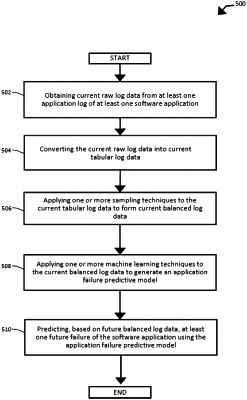| CPC G06F 11/004 (2013.01) [G06F 11/008 (2013.01); G06F 11/0709 (2013.01); G06F 11/0793 (2013.01)] | 19 Claims |

|
1. A computer-implemented method comprising:
converting, by at least one processor, current raw log data from or associated with at least one application log of at least one software application into current tabular log data;
configuring the current tabular data into a readable tabular format, via:
returning a dictionary list;
scanning a row of the dictionary list to generate keys that are used as column headers in the readable tabular format;
writing, to a comma-separated value (CSV) file, the keys that correspond to the column headers; and
writing rows from the dictionary list to fill the CSV file;
applying, by the at least one processor, one or more sampling techniques to the current tabular log data to form current balanced log data, wherein the current balanced log data includes previous incidents of failures of the at least one software application;
applying, by the at least one processor, one or more machine learning techniques to the current balanced log data to generate an application failure predictive model based at least in part on the previous incidents of failures of the at least one software application;
wherein one or both of the applying the one or more sampling techniques and/or the applying the one or more machine learning techniques are performed on the current tabular log data;
generating, by the at least one processor, at least one indication of at least one future failure of the software application based on one or both of future balanced log data and/or the application failure predictive model; and
causing, by the at least one processor, based on the at least one indication, at least one remedial activity to be performed to or with the software application to mitigate or avoid the at least one future failure of the software application.
|